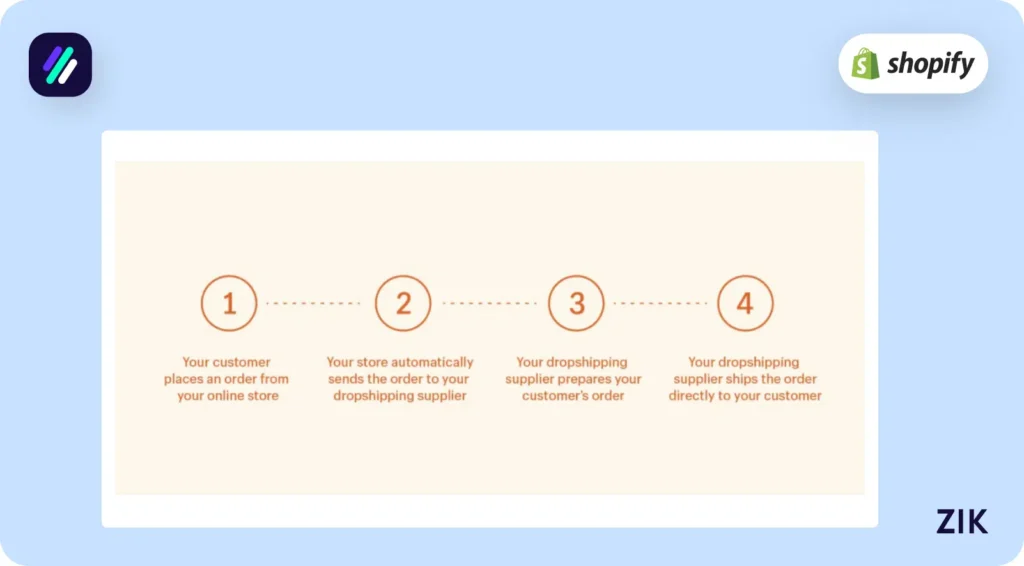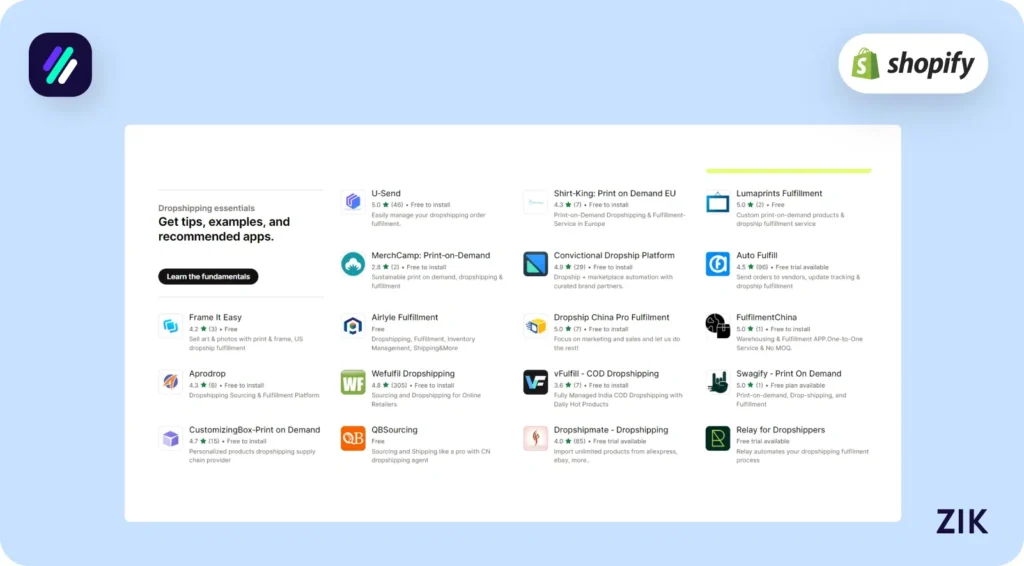So, you’ve officially launched your dropshipping business on Shopify!
Congrats on finally launching your dream business. Getting started is the hardest part, but be ready to take on more work because your journey to online business success is just beginning.
Once you find the hottest items to sell and promote them to your dropshipping store, expect more orders on Shopify! Keeping track of how those products perform with the Shopify sales tracker can also help you spot which items drive the most growth as you scale.

This article serves as your Shopify dropshipping guide to help you fulfill orders on Shopify efficiently.
When I started my online store years ago, I was most confused about the dropshipping fulfillment process.
Yet, it is critical to your e-commerce store because you want to manage orders as they come in and ensure the best shopping experience for your customers.
The Shopify App Store is a valuable resource for finding tools and apps like Oberlo to streamline the dropshipping order fulfillment process, enhancing your store’s efficiency and customer satisfaction.
In this guide, I’ll share how to fulfill dropshipping orders on Shopify.
Eliminate the trial-and-error process so you can fulfill more dropshipping orders and see a surge in sales!
Key Takeaways
- Order fulfillment is preparing, packing, and shipping orders from your dropshipping suppliers to customers.
- There are three order fulfillment methods: manual, automatic, and partial.
- Choosing among the three order fulfillment methods depends on your needs and the volume of orders in your Shopify store.
- Improve your dropshipping fulfillment strategy by choosing the right Shopify dropshipping suppliers, diversifying suppliers, and analyzing order fulfillment data.
What is Dropshipping Fulfillment?

Order fulfillment in a dropshipping business differs from other ecommerce store business models. As you might already know, when a customer orders from your dropshipping store, you don’t handle the fulfillment process because you forward the order information to your dropshipping suppliers.
Thus, you don’t technically fulfill orders on Shopify, but the supplier does on your behalf.
Third-party dropshipping suppliers are responsible for shipping labels, keeping stock of the items, and providing fulfillment services when a customer orders through your store.
Thus, as a seller, your sole responsibility is to find products to showcase on your online business website, and you won’t have to handle the dropshipping supply chain yourself.
Thus, it enables sellers to manage their Shopify store and receive multiple Shopify orders without building a team to handle dropship orders.
How to Fulfill Dropshipping Orders on Shopify
If you have a new Shopify website for dropshipping, you might be curious about how to fulfill Shopify orders on your Shopify store.
Regardless of the fulfillment method chosen, the process begins with a ‘request fulfillment’ step, where the store owner signals to the supplier or fulfillment service to start the order fulfillment process.
There are three common methods, and it’s up to you which fulfillment method you choose, as each has benefits and drawbacks.
Manual Order Fulfillment
The first method to fulfil dropshipping orders on Shopify is manual order fulfilment. As the name implies, this method allows you to manually fulfill orders for your Shopify dropshipping store.
You must log into your supplier’s website when fulfilling orders manually. From there, you must purchase the product your customer orders, input their shipping address, and select a shipping carrier for the order.
Choosing the right shipping carrier is crucial for ensuring the order is delivered to your customer in a timely and reliable manner.
Once you manually fulfill orders for your customers, you must wait for the supplier to ship the products to your customers. This process will deliver the package to your customers directly.
However, you must keep track of the shipping information and update the customers about their order status.
Manual order fulfillment can be done with or without a dropshipping tool. No matter which method you choose, it is crucial that your store automatically sends updates to your customers about their order status.
In addition, the manual dropshipping fulfillment method is easy for beginners or those online store owners who handle a relatively manageable volume of orders on Shopify.
However, when you are dealing with bulk orders on Shopify, this could easily be a time-consuming order fulfillment method. As a result, it could be tricky to keep track of the order status with so many orders on Shopify to monitor manually.
You can streamline the process of fulfilling orders by switching from manual fulfillment to another more streamlined process. Part of the manual fulfillment process involves creating or obtaining shipping labels for the orders.
Get insider tips—download the eBook on Shopify competitor research now!Automatic Order Fulfillment
Automatic fulfillment is another way to fulfill orders in your Shopify dropshipping business. It is fast and easy, and it is the preferred choice for online store owners handling multiple orders on Shopify.
Automatic fulfillment methods are available on Shopify. However, you need to integrate an automatic order fulfillment service to facilitate and streamline how you fulfill orders on your dropshipping store.
The first step is to find an automatic order fulfillment service that is accepted and compatible with Shopify. Once you have set up the third-party fulfillment service, it will generate a buyer account for you from the supplier’s website.
Then, the third-party fulfillment service will buy the products from your supplier and automatically update you about the order status through your Shopify admin dashboard. Hence, you won’t have to check each item manually or order for their individual statuses, saving you plenty of time to do other things for your ecommerce store.

The exact process works with manual order fulfillment, wherein the supplier prepares, packs, and ships the orders to your customer. The only difference is that you won’t have to manually fulfill orders, as the fulfillment service or dropshipping tool employed does that for you.
Depending on your system, automatic order fulfillment generates the tracking number and order details for each customer Shopify orders.
This integration of order tracking allows customers to receive real-time updates and tracking information once the supplier ships orders to their shipping details, enhancing customer satisfaction by providing visibility into their order status.
Partial Order Fulfillment
The third method of fulfilling Shopify orders is partial order fulfillment. This method involves partially fulfilling orders, which can depend on various circumstances involving your supplier and the availability of certain products on the customer’s order.
For example, a customer purchases several products from your Shopify website. However, half of those items are not in stock. Thus, you must partially fulfill orders by sending the Shopify orders to your supplier. They will ship products on hand to the customers’ addresses as specified in the order details. The rest of the products will be shipped once they become available later.
Developing Your Order Fulfillment Strategy for Dropshipping Shopify Orders
Now that you know the different fulfilment methods, it is crucial to building a strategy for your dropshipping fulfilment. This strategy helps you pick the most efficient dropshipping fulfillment that allows you to both manage inventory and fulfill dropshipping orders with ease.
Plus, the fulfillment process is critical to creating a positive customer experience because you want to ship orders in a timely manner and make sure that your customers get the products they want (and paid for!).
If you can master the order processing and dropshipping fulfillment stage, you can excel in Shopify dropshipping. Follow these tips to improve your dropshipping fulfillment strategy.
An inventory management system plays a pivotal role in streamlining the fulfillment process and ensuring product availability, making it an essential component of a successful fulfillment strategy.
1. Choose the right fulfillment method
When it comes to dropshipping fulfillment, speed is everything. Thus, choosing the most efficient order fulfilment method is critical to your success.
Manual order fulfilment is excellent for beginners or online store owners handling a manageable volume of Shopify orders. However, the automatic order fulfillment method works best for volume sellers or those handling a significant number of Shopify orders from their Shopify website.
2. Choose the Best Dropshipping Suppliers
Fulfilling a dropship order is more complicated than when you manage your own Shopify store and products. Therefore, choosing reliable dropshipping suppliers is vital to your success. Consider this when optimizing your Shopify dropshipping fulfilment methods.
The best dropshipping suppliers ensure they have a high-quality product and consistently deliver the product to their customers. In addition, you can ensure they can ship products as soon as you send them the order details.
Hence, you should not choose your suppliers based solely on the wholesale price but on their ability to optimize your dropshipping fulfillment needs.
3. Diversify Your Suppliers
Once you find a reliable supplier, maintain good relationships with them. It is critical to your Shopify dropshipping success as they can provide your customers with high-quality products.
However, it is important to diversify your suppliers to lower the risks involved in your business. For example, suppose your dropshipping supplier decides they want to stop production of certain products.
In that case, you don’t want to see your entire business collapse because of a business decision of your supplier. It is recommended that you diversify your supplier list such that you can continue to receive Shopify orders and be confident that your supplier will be able to fulfill them on your behalf.
4. Make Data-Driven Decisions
Data is a powerful tool to refine your dropshipping fulfillment strategy. Order fulfillment seems like a straightforward process, but small changes can make a difference in optimizing and delivering higher efficiency.
So, how do you analyze data when you fulfill customer orders? There are key metrics you must consider in this regard:
- Order Accuracy – It measures the percentage of orders shipped that were accurate to the customer’s order. This metric is crucial because it directly impacts customer satisfaction.
- On-Time Shipping – It refers to the percentage of orders that were delivered on time versus those that were delayed. The resulting percentage will give you insights into where and how you can improve the efficiency of the order processing and fulfilment methods.
- Order Cycle—It measures the time from when a customer purchases an item on your Shopify dropshipping store to when the customer receives their order.
- Fill Rate – This metric analyzes the percentage of customer orders that were fulfilled without issues, which you can evaluate alongside the inventory management process.
5. Automation
Several opportunities exist to automate the order fulfillment in your Shopify dropshipping business. Whether you’re using tools to find hot products to sell or using an automatic order fulfilment process, the right tool can increase efficiency in your business.
This is especially true when fulfilling orders, which can be time-consuming. Automating this process can help you focus on the core aspects of your business, enabling sellers to manage their resources effectively.
But, of course, you must carefully examine your order volume across sales channels. If you find yourself rushing or constantly having errors with fulfilling orders, it might be time to consider automating.
Challenges to Order Fulfillment You Must Avoid
The order fulfillment process is deceptively simple. Knowing the common challenges and pitfalls when you fulfill orders can help you prepare for and prevent them.
Effective supply chain management can play a crucial role in mitigating these challenges, ensuring a smoother order fulfillment process.
Incorrect Order Details
When choosing an order fulfilment method, make sure it is reliable enough to pass on accurate order details to each customer. A good system for managing customer order information and shipping details can save you a lot of trouble later on.
More importantly, it can eliminate negative customer experience.
Disruptions to the Supply Chain
Supply chain issues continue to plague online businesses, including Shopify dropshipping businesses. It becomes more challenging as more customers have higher expectations of delivery times.
Ensure you have a backup plan for order fulfillment, especially when your dropshipping suppliers encounter issues. Again, ensure you have more than one supplier to avoid relying on one supplier to keep your business running even when they experience disruptions.
Seasonal Fluctuations
Order volumes tend to spike at certain times of the year, depending on your niche and products. Therefore, learn to anticipate these seasonal trends to prepare your order fulfillment strategies for the sudden spike in demand.
Conclusion: Which Shopify Order Fulfillment is Right for You?
There you have it, a complete guide on how order fulfillment works when dropshipping in Shopify!
Knowing the different fulfilment methods for dropshippers will enable you to decide the best method for your needs or the volume of orders on Shopify.
This knowledge helps business owners take control of their business, allowing them to automate tasks where they need them or do manual order fulfillment if they’re just getting started.
Whichever fulfillment process you choose, remember that your work does not end once you fulfill orders on Shopify!
It’s just one aspect of your Shopify dropshipping business, and you need to consider after-sales customer service and online store promotion to help your business grow and not just thrive!
Launch Smarter After Learning How to Fulfill Dropshipping Orders on Shopify
Now that you know how to fulfill dropshipping orders on Shopify, it’s time to set up a store that’s ready to sell. ZIK’s AI Shopify store builder creates a fully designed, conversion-optimized store with data-backed winning products already inside. No guesswork, no delays, just a fast track to selling.
Frequently Asked Questions on How to Fulfill Orders on Shopify for Dropshipping
Here are some frequently asked questions on fulfilling dropshipping orders on Shopify:
How to fulfill orders on Shopify dropshipping?
To fulfill dropshipping orders, install an app like DSers, Spocket, or CJdropshipping, which syncs orders from your Shopify store to the supplier. Once a customer buys, you confirm and pay the supplier, who ships directly to the customer while tracking updates sync back automatically.
Does Shopify automatically fulfill orders for dropshipping?
No, Shopify itself does not automatically fulfill dropshipping orders. Instead, it relies on third-party apps like DSers, Spocket, or CJdropshipping to handle Shopify fulfillment. These apps process customer orders, forward details to suppliers, and update Shopify with shipping and tracking information automatically.
How do dropshippers fulfill orders?
Dropshippers fulfill orders by forwarding customer purchase details to their supplier, who then packs and ships the product directly to the buyer. With Shopify, apps like DSers, Spocket, or CJdropshipping automate this process, syncing orders, payments, and tracking updates seamlessly between store and supplier.
Do I have to manually fulfill orders on Shopify?
No, you don’t always have to fulfill orders manually on Shopify. You can enable automatic fulfillment in your settings or use apps like DSers, Spocket, or CJdropshipping for dropshipping. Manual fulfillment is still an option if you want full control over each order.
What is the fulfillment model of dropshipping?
The fulfillment model of dropshipping works by having the seller market and sell products without holding inventory. When a customer orders, the supplier receives the details, packages the product, and ships it directly to the buyer, while the seller manages pricing and customer service.
What happens when you press fulfill order on Shopify?
When you press Fulfill order on Shopify, it marks the items as shipped, lets you enter tracking details, and notifies the customer with a shipping confirmation email. If connected to an app or supplier, it can also trigger fulfillment and shipping automatically.
Who pays for shipping when selling on Shopify?
The customer usually pays for shipping on Shopify, unless you offer free shipping and include the cost in product prices. As the store owner, you set shipping rates, but you’re responsible for paying carriers or suppliers, so rates should cover fulfillment expenses.
How to fulfill a first order on Shopify?
To fulfill your first order, go to Orders in your Shopify admin, select the order, and click Fulfill items. Enter tracking details if available, then confirm fulfillment. If you use dropshipping apps like DSers or Spocket, the supplier handles shipping once you approve.
How long do you have to fulfill orders on Shopify?
Shopify doesn’t set a strict fulfillment deadline; it depends on your policies and supplier terms. Most stores aim to ship within 2–5 business days for customer satisfaction. Dropshippers should confirm supplier processing times and set clear shipping expectations to avoid disputes or chargebacks.
What is the best Shopify order tracking app?
The best Shopify order tracking apps are AfterShip, Track123, and Parcel Panel. AfterShip is great for global carriers and branded tracking pages, Track123 is popular for dropshipping stores with customizable updates, and Parcel Panel offers clean dashboards and reliable real-time tracking.
How to set up coming soon products on Shopify?
To set up coming soon products, add them in your Shopify admin, but leave inventory unavailable or set status to draft or active without sales channels. You can also use a “coming soon” app or theme customization to show the product page with a release date.













